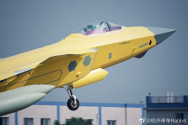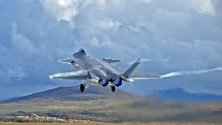Commemorating the anniversary with a legit article so I can wash the bad after taste of Minnie Chan and her WS-25 engine article from my mind.
The weeks leading up to January 11, 2011, marked a watershed episode for PLA watching. After years of cross-referencing enthusiast Chinese language defense chatter, monitoring the People’s Liberation Army’s operational security (OPSEC), carefully tracking rare semi-official and official statements, and debates about realism and ambition, the elusive fifth generation fighter project known since the mid-2000s variously as J-XX, J-13, J-14, XXJ, finally emerged in blurry poor-quality pictures at Chengdu Aircraft Corporation’s (CAC) factory from late December 2010. It arrived right on schedule.
As clearer pictures percolated from Chinese-language defense boards to the English language PLA watching forums, and then onto aerospace and defense blogs and mainstream alphabet soup media outlets, the finalized designation – J-20 – became accepted and widely used. Finally, on the aforementioned date, the first J-20 technology demonstrator conducted a successful maiden flight, accompanied by a J-10AS twin-seater chase plane.
In the years since then, including , much has been said and debated over the exact military and strategic consequences of the emergence of J-20 and the kind of fighter it will be. Less spoken of is the vindication and emergence of the modern PLA watching grapevine and methodology, whose open-source collaboration and dissemination of information was at the time able to predict various key aspects of the aircraft’s characteristics, milestones, and parameters, months or in many cases years before they were conveyed by traditional defense media or open-source government and military publications.
Big ticket PLA projects prior to the J-20 – such as the J-10 fourth generation fighter, 054/A frigates, 052B/C destroyers, and KJ-2000 AEW&C – all enjoyed their own lengthy period of speculation and analysis prior to their unveiling, but the limited number of stealth fighter types in the mid-2000s up to J-20’s maiden flight put the methodology of PLA watching to the test, which it ultimately passed with flying colors. It is not an exaggeration to say that since the J-20, the predictions and anticipation for various big ticket PLA projects that have emerged – the 052D and 055 destroyers, Y-20 strategic transport, FC-31 5th generation demonstrator, 002 and 003 aircraft carriers, 075 amphibious assault ship, among many others – as well as, various projects to emerge in the near future – the FC-31 derived carrier-borne fifth generation fighter, H-20 stealth bomber, and next generation surface combatants – would not have been taken seriously had the years of lead up to J-20 not so accurately predicted aspects of the aircraft, from configuration to role to expected arrival period.
It is in this context that the first decade of the J-20’s development, entry into service, and maturation will be discussed and reflected upon, and the prospects for its second decade be considered.
Reactions and Controversies
It is interesting to examine, in retrospect, how much of the initial English-language media reaction to J-20’s emergence remains unchanged today.
Initial, incorrect estimates of the J-20’s length have proven to be the biggest mistake (pun perhaps slightly intended), placing it at a gargantuan 22-23 . In subsequent years, many comparative analyses of the aircraft revised its length down to about 20.8 meters (still a large fighter providing significant internal volume), but far from the 23-meter estimates initially circulated. Alas, the effect lingers, for in successive years and even to now, the most popular descriptions of the aircraft’s role portray it as a or a , both no doubt initially informed by incorrect overestimates of the aircraft’s size (and by extension, overestimates of its range as well as weapons bay dimensions).
Notwithstanding the consistent earliest Chinese-language defense rumors and subsequent official AVIC confirmation of the J-20’s role, it appears that in the foreseeable future J-20 will largely be seen by the media as an interceptor or a strike aircraft rather than an air superiority fighter (perhaps until the PLA Air Force feels comfortable enough to allow the aircraft to demonstrate more of its flight envelope or until the aircraft receives engines with thrust vectoring and conducts a Pugachev’s Cobra at the Zhuhai Air Show). Nevertheless, as every year passes, it is difficult to assess if foreign commentary on the J-20’s role reflects a genuine consideration of evidence or arises from some underlying discomfort or disbelief that a PLA stealth fighter may be intended to compete in a generally symmetric way with the F-22 and F-35, the former of which in particular has attained something of a mythic status in defense watching circles.
Last edited:


